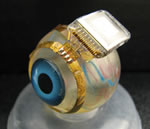
Carnegie
Mellon professor has developed a retinal prosthesis that restores sight
to the blind:
"My group has created a micro-fabricated thin film that is
inserted behind the retina of the human eye. From this thin plastic
film, the width of an eyelash, flexible electrodes send stimulating
current signals to retinal nerves. A miniature microchip located in
a titanium package generates these stimulating currents. That package
is attached to the patient's eye, and receives image signals from specially
designed glasses worn by a visually impaired patient. My device works
very much like a camera, replacing the function of the rods and cones
of the human eye," Kelly said.
To the novice, the eye operates on the same principle as the camera
- the only machine directly modeled on a sense organ. The eye, however,
takes two simultaneous pictures, one in black and white, the other in
color. Cells in the retina, called rods, register black and white only;
they are so sensitive they can detect light as faint as 100-trillionth
of a watt. Other retinal cells, the cones, are affected by color and
are most abundant at the fovea, the place where the image falls when
the eye focuses. The blind spot, lacking both rods and cones, is where
the optic nerve leaves the retina, carrying the pictures for the brain
to see.
It looks better than having a tooth
planted in your eye:
More
 Carnegie
Mellon professor has developed a retinal prosthesis that restores sight
to the blind:
Carnegie
Mellon professor has developed a retinal prosthesis that restores sight
to the blind:
No comments:
Post a Comment